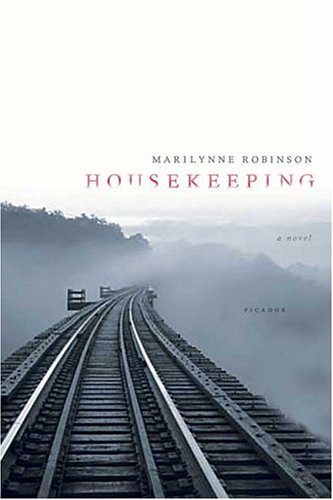Near the beginning of Marilynne Robinson’s 1980 novel Housekeeping, narrator Ruth Stone describes an act of violent substitution that resonates through the harrowing events to follow. Ruth tells how her grandfather, the patriarch of the family, had emerged from a subterranean dwelling—“no more a human stronghold than a grave”—on the plains of the American West to build a sprawling homestead along an ancient mountain lake called Fingerbone. Into that lake the grandfather then fatally plunges on a moonless night when a spectacular derailment sends his train down to the watery depths, leaving nothing but “a suitcase, a seat cushion, and a lettuce." If the descent of the train—that signal exemplar of technological modernity—to the pit of the lake suggests a loss of master narratives, the conversion of the patriarch and two other train-riders into the most mundane, transient artifacts (valise, cushion, vegetable) inaugurates the cycles of object-oriented temporality into which Ruth’s family then moves. Stripped from illusions of progressive advance, Ruth tells us, the family “had no reason to look forward, nothing to regret. Their lives spun off the tilting world like thread off a spindle. Breakfast time. Supper time. Lilac time. Apple time.”
Placed within an “outsized landscape” whose door history had
never really darkened, life in the rambling house begins to sway. For, beneath
the plashing blue Fingerbone lie older waters “smothered and nameless and
altogether black”—waters that reek of the dead and, like a good Latourian
hybrid, are “full of people." And with the new regime of Ruth’s aunt
Sylvie installed in the lakeside home, management of the oikos becomes a
veritable satire of bourgeois economics. Thrift is demonstrated as the family amasses
and arrays valueless items. Meals are eaten in the dark as the boundaries
between house and landscape, nature and culture, become ever more permeable.
All the while, the lake brims and swells with the persisting materials it holds
in cold storage as they await their fiduciary, cognitive, and eschatological
redemptions. In a reverie, Ruth imagines sweeping a giant net across “the black
floor of Fingerbone [to find] a great army of berry gatherers and hunters and
strayed children. There would be a general reclaiming of fallen buttons and
misplaced spectacles, of neighbors and kin, till time and error and accident
were undone, and the world became comprehensible and whole.” For what, she
wonders, “are all these fragments for, if not to be knit up finally?”
In her stimulating paper, Pamela Karimi quotes Daniel
Miller’s claim that “just as there is no pre-objectified culture, there is no
post-objectified transcendence.” Yet, the desire for Ruth enunciates for
restitution amidst and for the serried thickness of material life—a movement
from fragmentation to redemption, to adopt Caroline Walker Bynum’s turn of
phrase—resounds through much recent writings in material culture studies, thing
theory and the conjunction of anthropological, SSK and other fields I take to
be denoted by the label “new materialism.” Finding counterpoint to the
dystopian textures of Philip K. Dick’s futures in his fictive conceptions of
humble clay pots, Bill Brown, for one, has staked out the interpretive hope
driving the thing theorist’s “methodological fetishism” (in Arjun Appadurai’s
famous phrase) as a tactical suspension of the hermeneutics of suspicion. This
is, Brown writes “not an error so much as it is a condition for thought, new
thoughts about how inanimate objects constitute human subjects, how they move
them, how they threaten them, how they facilitate or threaten their relation to
other subjects.” And while recent scholars following, say, Pamela Smith and
Michael Cole have used works of seemingly excessive materiality to positively
valorize “artisanal epistemology” or the intelligence of the goldsmith, it is
useful to recall the tone and directionality subtending the materialist’s
preferred genre of the case study. As literary historian Jim Chandler reminds
us, “the word case, as its etymological root suggests, has to do with falls and
befallings, with the world of chance and contingency and the positing of worlds
– normative orders – against which chance and contingency might be established
as such.”
Falling like a stone—falling like Helen Stone, the mother of
our narrator in Housekeeping, into the dark lake—brings us back to Ed Eigen’s
scintillating talk. While his felicitous title “Lithographies” nearly
literalizes the writing of her Family Stone that Ruth Stone undertakes in the
novel, the dispersal of staining, stony materials across the face of waters
that he narrates so compellingly echoes Ruskin’s scattering of miniature stones
in dust even as it evokes Housekeeping’s seeming flat plot. Yet, like the
“stone oil” or petroleum that pools and pulses below the Middle Eastern cities
in Pamela Karimi’s analysis, the hegemonic force of those liquids to organize
the thoughts and plots of those above becomes increasingly insistent as Housekeeping
reaches its violent climax. “What is thought, after all,” Ruth asks as she
sails above the eternal, encyclopedic museum of material life that is the lake,
“what is dreaming, but swim and flow, and the images they seem to animate?”
Like the swirling waters of the planet Solaris in Andrei Tarkovsky’s classic
film, these dark, deep immiscible materials that drive wars so that we can
drive cars or that enable the production of marbled accidents continue their
economies—they continue to keep house—below us, beneath us, in us.

No comments:
Post a Comment